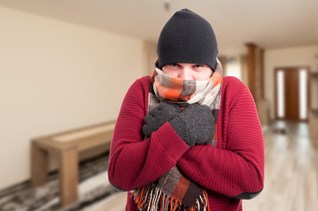Your guide to heating in the workplace
24 February 2022
By law, your place of work is required to meet a ‘reasonable’ temperature that is different based on the nature of the work taking place. This temperature should be reached without the requirement of special clothing and if this is not achieved, steps should be taken.
Know that in your indoor work environment, it is the law for a sufficient amount of thermometers to be provided so that you can know and control your temperature. These tools should be kept close to your work station and at your level to ensure maximum accuracy. According to the Workplace (Health, Safety and Welfare) Regulations 1992, the minimum temperature of your work environment should be ‘at least 16 degrees Celsius. If work involves rigorous physical effort, the temperature should be at least 13 degrees Celsius.’ This is not the case in environments in which the purpose of the room is to be hot or cold, i.e. a chiller.

Any method of heating or cooling that is provided must not release fumes, gas or vapour into the air to the point where they could be dangerous to another human. This suggests that it is vital to have both a carbon monoxide alarm monitoring your boiler's emissions and an annual service. The regulations suggest ideas of reducing heat such as insulating warm pipes, introducing an air cooling plant or shading windows. In extreme hot weather, it is suggested that fans and increased ventilation are used.
Follow the handy tips below to ensure that your staff are happy within their work environment.
For when your staff are too hot:
Consider rearranging the office. In every office there is always someone who is too hot and someone that is too cold, so make sure those who are by the window are well chosen.
Ensure that the windows are openable. If not, invest in some fans for the desks. Even USB fans are not costly, are space saving and are ideal for an office environment.
Ensure that your staff have access to cool water or enough breaks to go and cool down throughout a hot day.
Introduce plants to the office. Not only do they look good, but they produce oxygen, eliminate toxins and cool the air.
Make sure that the dress code is suitable for the environment. Formal wear does look smart, however suits can be especially warm within summer - consider dress down days.
For when your staff are too cold:
Similar to any home, it is important to insulate rooms and ensure that there are no draughts causing your workplace to be cold.
Have carpeted or insulated floor so that your staff don’t feel like they need to be wearing their slippers to work.
Introduce the appropriate clothing like company fleeces or extra layers. This will maintain the smart appearance of your workers whilst offering a warm solution.

For external cold conditions:
Ensure that both Personal Protective Equipment and thermal wear are available for your staff. Overall, just make sure that your staff are dressed appropriately to prevent illness.
Consider providing on-the-go, mobile areas for your staff to break in and warm up.
For external warm conditions:
Introduce shaded areas for your staff members to break in and cool down from the sun.
You could rearrange work duties to later in the day when the sun is lower.
Talk to your staff members about what they can do to protect themselves.
As a manager, if your employees are complaining about the temperature of your environment, you should perform a risk assessment.
Download a thermal comfort checklist from the Health and Safety Executive here.
Within a risk assessment, you can address the air temperature, radiant temperature, movement of air and the humidity of the office. You should already have a thermostat that will tell you the focal temperature however, for other factors, you may need other equipment.
Also question the dress code that you have given for your work force and if the physicality of the work is too gruelling for the temperature.
Many types of heating are available and, at Swale Heating, we have provided heat for many commercial and private customers. Consider a new water-based, underfloor, electric or combined heating system that we can install and maintain for you.
Make sure that you know the symptoms of heat and cold stress to ensure that your workforce are healthy and fit to perform their tasks.
Contact us to see the services that we can offer you here.